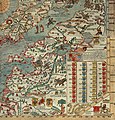Varniai
- View a machine-translated version of the Lithuanian article.
- Machine translation, like DeepL or Google Translate, is a useful starting point for translations, but translators must revise errors as necessary and confirm that the translation is accurate, rather than simply copy-pasting machine-translated text into the English Wikipedia.
- Do not translate text that appears unreliable or low-quality. If possible, verify the text with references provided in the foreign-language article.
- You must provide copyright attribution in the edit summary accompanying your translation by providing an interlanguage link to the source of your translation. A model attribution edit summary is
Content in this edit is translated from the existing Lithuanian Wikipedia article at [[:lt:Varniai]]; see its history for attribution. - You may also add the template
{{Translated|lt|Varniai}}to the talk page. - For more guidance, see Wikipedia:Translation.

 Lithuania
LithuaniaVarniai (pronunciationⓘ; Samogitian: Varnē; Polish: Wornie) is a city in the Telšiai County, western Lithuania. In the Middle Ages the city was known as Medininkai (Samogitian: Medėninkā).
History
It was established in the 14th century, on the bank of the Varnelė River, near an important Samogitian castle. It was the center of Samogitian Catholic church: after the baptism of Samogitia, the Samogitian Bishop resided in the town. In 1320, it was the site of the Battle of Medininkai, in which the Samogitians defeated the invading Teutonic Knights.[1] Afterwards, it was invaded by the Teutonic Knights in 1329, and by the Livonian Order in 1377.[1] In 1413, Polish King Władysław II Jagiełło and Lithuanian Duke Vytautas ordered the demolition of the pagan temple and Christianized the population.[1] Around 1414–1416 the first church was built, and c. 1464 the first cathedral. 1425, a third of the population died due to an epidemic.[2] It was granted Chełmno municipal rights in 1491.[2] During the Swedish invasion, the town was plundered by the Swedes in 1655 and 1656.[2] Five diocesan synods were held in the town between 1656 and 1752.[2]
Varniai was the center of Samogitian episcopate until the middle of the 19th century, when authorities of the Russian Empire moved it to Kaunas.
With support of Merkelis Giedraitis, Mikalojus Daukša translated and made ready for publication Katechizmas, the first Lithuanian language book printed in the Grand Duchy of Lithuania, then part of the Polish–Lithuanian Commonwealth.
It was also residence of Motiejus Valančius.
Gallery
-
 Varniai as depicted in Carta marina
Varniai as depicted in Carta marina -
 One of the Varniai streets
One of the Varniai streets - Samogitian Diocese seat in Varniai
-

- Interior of the Church of St. Peter and St. Paul
- Bishops of Samogitia sarcophagus in the Church of St. Peter and St. Paul basement
- St. Alexander's Church
- Varniai Centre of Culture
-
 Varniai eldership building
Varniai eldership building - Merkelis Giedraitis Monument
- Mikalojus Daukša Monument
- Motiejus Valančius Monument
- Former house of Motiejus Valančius
- Varniai Motiejus Valančius Gymnasium
Notable residents
References
- ^ a b c Słownik geograficzny Królestwa Polskiego i innych krajów słowiańskich, Tom XIII (in Polish). Warszawa. 1893. p. 941.
{{cite book}}: CS1 maint: location missing publisher (link) - ^ a b c d Słownik geograficzny Królestwa Polskiego i innych krajów słowiańskich, Tom XIII (in Polish). Warszawa. 1893. p. 942.
{{cite book}}: CS1 maint: location missing publisher (link)
External links

- (in Lithuanian) Varniai – A Resourceful Renaissance Center of 16th Century Cultural and National Ideology
- (in Lithuanian) Park of Varniai and history of Varniai
- (in Lithuanian) Museum of Samogitian episcopate
- (in Lithuanian) Website of Varniai

























